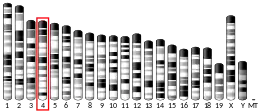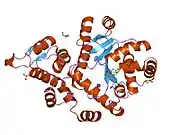YARS
Tyrosyl-tRNA synthetase, cytoplasmic, also known as Tyrosine-tRNA ligase, is an enzyme that in humans is encoded by the YARS gene.[5][6][7]
| YARS1 | |||||||||||||||||||||||||||||||||||||||||||||||||||
|---|---|---|---|---|---|---|---|---|---|---|---|---|---|---|---|---|---|---|---|---|---|---|---|---|---|---|---|---|---|---|---|---|---|---|---|---|---|---|---|---|---|---|---|---|---|---|---|---|---|---|---|
 | |||||||||||||||||||||||||||||||||||||||||||||||||||
| |||||||||||||||||||||||||||||||||||||||||||||||||||
| Identifiers | |||||||||||||||||||||||||||||||||||||||||||||||||||
| Aliases | YARS1, CMTDIC, TYRRS, YRS, YTS, tyrosyl-tRNA synthetase, tyrosyl-tRNA synthetase 1, YARS, IMNEPD2 | ||||||||||||||||||||||||||||||||||||||||||||||||||
| External IDs | OMIM: 603623 MGI: 2147627 HomoloGene: 2730 GeneCards: YARS1 | ||||||||||||||||||||||||||||||||||||||||||||||||||
| |||||||||||||||||||||||||||||||||||||||||||||||||||
| |||||||||||||||||||||||||||||||||||||||||||||||||||
| |||||||||||||||||||||||||||||||||||||||||||||||||||
| |||||||||||||||||||||||||||||||||||||||||||||||||||
| |||||||||||||||||||||||||||||||||||||||||||||||||||
| Wikidata | |||||||||||||||||||||||||||||||||||||||||||||||||||
| |||||||||||||||||||||||||||||||||||||||||||||||||||
Living cells translate DNA sequences into RNA sequences and then into protein sequences. Proteins are chains of amino acids, such as tyrosine. As the protein grows, each amino acid is added to the end by an enzyme called transfer RNA (tRNA). Each amino acid has its own tRNA, and tyrosyl-tRNA synthetase is the tRNA that adds tyrosine to the end of a growing protein.
Aminoacyl-tRNA synthetases catalyze the aminoacylation of transfer RNA (tRNA) by their cognate amino acid. Because of their central role in linking amino acids with nucleotide triplets contained in tRNAs, aminoacyl-tRNA synthetases are thought to be among the first proteins that appeared in evolution. Tyrosyl-tRNA synthetase belongs to the class I tRNA synthetase family. Cytokine activities have also been observed for the human tyrosyl-tRNA synthetase, after it is split into two parts, an N-terminal fragment that harbors the catalytic site and a C-terminal fragment found only in the mammalian enzyme. The N-terminal fragment is an interleukin-8-like cytokine, whereas the released C-terminal fragment is an EMAP II-like cytokine.[7]
Recently, tyrosyl-tRNA synthetase has been demonstrated as the biologically and functionally significant target for resveratrol.[8]
For a comparison of cytoplasmic human tyrosyl-tRNA synthetase with its mitochondrial counterpart and with tyrosyl-tRNA synthetases of other biological kingdoms and organisms, see the Wikipedia page on Tyrosine-tRNA ligase and a general review on their structures and functions.[9]
References
- GRCh38: Ensembl release 89: ENSG00000134684 - Ensembl, May 2017
- GRCm38: Ensembl release 89: ENSMUSG00000028811 - Ensembl, May 2017
- "Human PubMed Reference:". National Center for Biotechnology Information, U.S. National Library of Medicine.
- "Mouse PubMed Reference:". National Center for Biotechnology Information, U.S. National Library of Medicine.
- Ribas de Pouplana L, Frugier M, Quinn CL, Schimmel P (Feb 1996). "Evidence that two present-day components needed for the genetic code appeared after nucleated cells separated from eubacteria". Proc Natl Acad Sci U S A. 93 (1): 166–70. Bibcode:1996PNAS...93..166R. doi:10.1073/pnas.93.1.166. PMC 40199. PMID 8552597.
- Kleeman TA, Wei D, Simpson KL, First EA (Jun 1997). "Human tyrosyl-tRNA synthetase shares amino acid sequence homology with a putative cytokine". J Biol Chem. 272 (22): 14420–5. doi:10.1074/jbc.272.22.14420. PMID 9162081.
- "Entrez Gene: YARS tyrosyl-tRNA synthetase".
- Sajish, Mathew; Schimmel, Paul (2015). "A human tRNA synthetase is a potent PARP1-activating effector target for resveratrol". Nature. 519 (7543): 370–373. Bibcode:2015Natur.519..370S. doi:10.1038/nature14028. PMC 4368482. PMID 25533949.
- Bedouelle, Hugues (2013). Tyrosyl-tRNA Synthetases.
{{cite book}}:|website=ignored (help)
Further reading
- Ewalt KL, Schimmel P (2002). "Activation of angiogenic signaling pathways by two human tRNA synthetases". Biochemistry. 41 (45): 13344–9. doi:10.1021/bi020537k. PMID 12416978.
- Maruyama K, Sugano S (1994). "Oligo-capping: a simple method to replace the cap structure of eukaryotic mRNAs with oligoribonucleotides". Gene. 138 (1–2): 171–4. doi:10.1016/0378-1119(94)90802-8. PMID 8125298.
- Suzuki Y, Yoshitomo-Nakagawa K, Maruyama K, et al. (1997). "Construction and characterization of a full length-enriched and a 5'-end-enriched cDNA library". Gene. 200 (1–2): 149–56. doi:10.1016/S0378-1119(97)00411-3. PMID 9373149.
- Wakasugi K, Quinn CL, Tao N, Schimmel P (1998). "Genetic code in evolution: switching species-specific aminoacylation with a peptide transplant". EMBO J. 17 (1): 297–305. doi:10.1093/emboj/17.1.297. PMC 1170380. PMID 9427763.
- Wakasugi K, Schimmel P (1999). "Two distinct cytokines released from a human aminoacyl-tRNA synthetase". Science. 284 (5411): 147–51. Bibcode:1999Sci...284..147W. doi:10.1126/science.284.5411.147. PMID 10102815.
- Wakasugi K, Schimmel P (1999). "Highly differentiated motifs responsible for two cytokine activities of a split human tRNA synthetase". J. Biol. Chem. 274 (33): 23155–9. doi:10.1074/jbc.274.33.23155. PMID 10438485.
- Austin J, First EA (2002). "Catalysis of tyrosyl-adenylate formation by the human tyrosyl-tRNA synthetase". J. Biol. Chem. 277 (17): 14812–20. doi:10.1074/jbc.M103396200. PMID 11856731.
- Austin J, First EA (2002). "Potassium functionally replaces the second lysine of the KMSKS signature sequence in human tyrosyl-tRNA synthetase". J. Biol. Chem. 277 (23): 20243–8. doi:10.1074/jbc.M201923200. PMID 11927599.
- Wakasugi K, Slike BM, Hood J, et al. (2002). "Induction of angiogenesis by a fragment of human tyrosyl-tRNA synthetase". J. Biol. Chem. 277 (23): 20124–6. doi:10.1074/jbc.C200126200. PMID 11956181.
- Austin J, First EA (2002). "Comparison of the catalytic roles played by the KMSKS motif in the human and Bacillus stearothermophilus trosyl-tRNA synthetases". J. Biol. Chem. 277 (32): 28394–9. doi:10.1074/jbc.M204404200. PMID 12016229.
- Yang XL, Skene RJ, McRee DE, Schimmel P (2003). "Crystal structure of a human aminoacyl-tRNA synthetase cytokine". Proc. Natl. Acad. Sci. U.S.A. 99 (24): 15369–74. doi:10.1073/pnas.242611799. PMC 137723. PMID 12427973.
- Strausberg RL, Feingold EA, Grouse LH, et al. (2003). "Generation and initial analysis of more than 15,000 full-length human and mouse cDNA sequences". Proc. Natl. Acad. Sci. U.S.A. 99 (26): 16899–903. Bibcode:2002PNAS...9916899M. doi:10.1073/pnas.242603899. PMC 139241. PMID 12477932.
- Jia J, Li B, Jin Y, Wang D (2003). "Expression, purification, and characterization of human tyrosyl-tRNA synthetase". Protein Expr. Purif. 27 (1): 104–8. doi:10.1016/S1046-5928(02)00576-4. PMID 12509991.
- Gevaert K, Goethals M, Martens L, et al. (2004). "Exploring proteomes and analyzing protein processing by mass spectrometric identification of sorted N-terminal peptides". Nat. Biotechnol. 21 (5): 566–9. doi:10.1038/nbt810. PMID 12665801. S2CID 23783563.
- Jordanova A, Thomas FP, Guergueltcheva V, et al. (2004). "Dominant intermediate Charcot-Marie-Tooth type C maps to chromosome 1p34-p35". Am. J. Hum. Genet. 73 (6): 1423–30. doi:10.1086/379792. PMC 1180404. PMID 14606043.
- Yang XL, Otero FJ, Skene RJ, et al. (2004). "Crystal structures that suggest late development of genetic code components for differentiating aromatic side chains". Proc. Natl. Acad. Sci. U.S.A. 100 (26): 15376–80. doi:10.1073/pnas.2136794100. PMC 307575. PMID 14671330.
- Ota T, Suzuki Y, Nishikawa T, et al. (2004). "Complete sequencing and characterization of 21,243 full-length human cDNAs". Nat. Genet. 36 (1): 40–5. doi:10.1038/ng1285. PMID 14702039.







